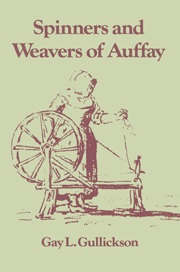 The Spinners and Weavers of Auffay
The Spinners and Weavers of Auffay Book contents
- Frontmatter
- Contents
- Preface
- 1 Introduction
- 2 The pays and the village
- 3 Proto-industrial theory and the pays de Caux
- 4 The golden age of spinning
- 5 Crisis and change in the Caux
- 6 The golden age of cottage weaving
- 7 Marriage and family in proto-industrial Auffay
- 8 Widowhood, remarriage, and the sexual division of labor
- 9 Unwed mothers and their children
- 10 Conclusions: the causes and consequences of proto-industrialization
- Appendix Vital statistics for Auffay
- Notes
- Bibliography
- Index
7 - Marriage and family in proto-industrial Auffay
Published online by Cambridge University Press: 29 October 2009
- Frontmatter
- Contents
- Preface
- 1 Introduction
- 2 The pays and the village
- 3 Proto-industrial theory and the pays de Caux
- 4 The golden age of spinning
- 5 Crisis and change in the Caux
- 6 The golden age of cottage weaving
- 7 Marriage and family in proto-industrial Auffay
- 8 Widowhood, remarriage, and the sexual division of labor
- 9 Unwed mothers and their children
- 10 Conclusions: the causes and consequences of proto-industrialization
- Appendix Vital statistics for Auffay
- Notes
- Bibliography
- Index
Summary
On February 10, 1783, Marie Marguerite Varin, a domestic servant, married Jacques Etienne Frichet, a weaver. He was twenty-seven and she was twenty-five. Neither had been married before, and both were residents of Auffay. If the wedding was typical, the couple and the wedding party were conducted to and from the church by a violinist dressed in culottes and a frock coat who, after the ceremony, played while people danced and celebrated the nuptials.
Following the established custom, the fiddler would have returned to Jacques Etienne and Marie Marguerite's home on February 11 to lead them once more to the church for a celebration Mass. When they left the church this time, however, the couple was not led home by the violinist. Instead, they found a group of friends and a donkey waiting for them in front of the cemetery wall. They were mounted on the donkey who, if he was cooperative, heightened the comic mood by braying loudly. The donkey was then led through the streets by a long rope. Two young men were stationed on either side to keep the feted couple from falling or jumping off and escaping. A third lighted the way with an old stable lantern held aloft on the end of a pole, while a fourth encouraged the donkey with a bouquet of hay stuck on the end of a stick.
- Type
- Chapter
- Information
- The Spinners and Weavers of AuffayRural Industry and the Sexual Division of Labor in a French Village, pp. 129 - 161Publisher: Cambridge University PressPrint publication year: 1986
- 1
- Cited by
